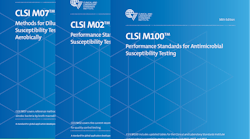It’s back! Dear API Abby is here to answer a series of commonly asked questions about laboratory quality. This time, the American Proficiency Institute (API) is offering its technical expertise to respond to questions about the CLIA final rule on proficiency testing (PT) analytes and acceptable performance. The American Proficiency Institute, a global leader in proficiency testing programs, is dedicated to improving the accuracy and efficiency of clinical laboratory testing. Known for its constant innovation in the field, API offers technical expertise and checklists to help its laboratory customers become more proficient.
Dear API Abby:
It seems like it’s been a while since the federal government ordered laboratories to make proficiency testing changes. I’m responsible for ordering PT programs for my laboratory, but nobody has told me what needs to change. Would you tell me what I need to do? I want to be in compliance!
Law-Abiding Laboratorian
Dear Law-Abiding:
Kudos to you for keeping up with the latest regulatory activities! We understand the confusion. The Centers for Medicare & Medicaid Services (CMS) issued a final rule on July 11, 2022, that updated the CLIA regulations related to PT analytes and acceptable performance. The final rule went into effect a month later in 2022, but many of the provisions will be implemented on January 1, 2025.
CMS recognized that preparation was needed on the part of laboratories, proficiency testing providers, accrediting organizations, surveyors, and exempt States before all provisions were ready to go. This two-year time period allows PT providers time to produce appropriate samples and update their analyte scoring and reporting requirements. It gives laboratories, like yours, time to enroll in the new, and sometimes revised, PT programs.
What do you need to do? Ahead of your 2025 enrollment, start identifying analytes that you test that have been added to the required list in the final rule. You should expect details about changes to PT programs as the enrollment period draws near. Keep an eye on your PT provider’s website; most have already posted information about the CLIA changes.
Dear API Abby:
As a medical laboratory scientist of long standing, I’m well aware of the analytes that require PT under CLIA. I understand the final rule has changed the list of required analytes. Would you explain the change and which analytes are now on the list?
Coming Up to Speed
Dear Compatriot:
Indeed, a few decades have passed since the initial list of required PT analytes was mandated. CMS and the Centers for Disease Control and Prevention (CDC) undertook an extensive review of the analytes to determine which ones should remain on the list, which ones should be deleted, and what new analytes should be added.
The newly required analytes are as follows:
General Immunology
C-reactive protein (high sensitivity), Anti-HBs, Anti-HCV
Routine Chemistry
B-natriuretic peptide (BNP), NT proBNP, Carbon dioxide (CO2), Cholesterol, low density lipoprotein (LDL), (direct measurement), Ferritin, Gamma glutamyl transferase (GGT), Hemoglobin A1c, Phosphorus, Prostate specific antigen (PSA) total, Total iron binding capacity (TIBC) (direct measurement), Troponin I, Troponin T
Endocrinology
Cancer antigen (CA) 125, Carcinoembryonic antigen (CEA), Estradiol, Folate, serum, Follicle stimulating hormone (FSH), Luteinizing hormone, Parathyroid hormone, Progesterone, Prolactin, Testosterone, Vitamin B12
Toxicology
Acetaminophen, serum, Salicylate, Vancomycin
Hematology
Blood cell identification, White blood cell differential, Erythrocyte count, Hematocrit (excluding spun microhematocrit), Hemoglobin, Leukocyte count, Platelet count, Fibrinogen, Partial thromboplastin time, Prothrombin time (seconds or INR)
Although both blood cell identification and white blood cell differential have always been scored, only one of the scores was sent to CMS — even if laboratories reported both in their PT results. The final rule changes this practice so that now both scores will be sent to the agency.
The final rule also states that laboratories must report prothrombin time in the same way as they report patient results. This means that in addition to seconds, units of reporting for prothrombin time can include INR (international normalized ratio), which was previously not considered regulated. Laboratories not currently testing five samples, three times a year for INR will need to enroll in the appropriate PT program.
Dear API Abby:
To PT or not to PT, that is my question. It seems that there are more analytes being scored for microbiology, but we’ve been ordering proficiency testing programs for each microbiology subspecialty. How do these changes affect us?
The Hamlet of PT
Dear Hamlet:
Thou shalt PT, Dear Hamlet! You are perceptive though regarding changes in the microbiology proficiency testing requirements.
Within each subspecialty (bacteriology, mycobacteriology, mycology, parasitology, and virology), laboratories are responsible for ensuring that various types of testing are included. The final rule adds some new types of testing to some subspecialties.
Newly scored analytes include Gram Stain morphology, bacterial toxin detection (e.g. C. difficile and Shiga toxins), mycology and parasitology antigen testing (e.g. Cryptococcal and Trichomonas antigens), molecular detection of Mycobacterium tuberculosis, and molecular detection of parasites, yeast, and fungi. The final rule also requires antimicrobial susceptibility testing to be reported on two samples per test event, covering both Gram positive and Gram negative organisms. Another change is that mycobacterial susceptibility is no longer scored, so those scores will not be shared with your accreditation agency come 2025.
So, dear Hamlet, what does all this mean for you? Your proficiency testing order actually might stay the same, though your PT provider may increase the number of samples included in each test event to meet the minimum requirement. Nonetheless, it would be prudent for you to review your order against these changes to make certain your laboratory remains in compliance. Lastly, since you’ve probably already been testing and reporting results for these analytes, but they are now regulated, results for these analytes will now be included in your overall score for each subspecialty that is shown on your evaluation.
Dear API Abby:
I aim to submit my proficiency test results completely and accurately each and every time! Admittedly, sometimes, I want to make a correction or add information after the testing due date. Am I allowed to do so or may my proficiency testing provider do it for me?
Only Human
Dear Only Human:
We can certainly sympathize with being human and the pressure not to make mistakes. However, CLIA does not allow laboratories or PT providers any latitude after the due date for results. The final rule reinforces this and states, “it is not appropriate for a PT program to change or add information on the PT result submission from a laboratory, including, but not limited to, the testing methodology, results, data, or units.” So, this is a strong line not to cross.
It is important to read instructions carefully to ensure you are reporting in the correct units and selecting the appropriate method. Reach out to your PT provider if your unit of measure or method is not listed. You may be asked to document this information with your results. Always proof your completed results carefully prior to submitting. If you happen to find a correction after you submitted but before the due date, your PT provider can likely help you. Unfortunately, after the due date everything must be considered your “final answer”!
Dear API Abby:
In addition to changes in the list of regulated analytes, the final rule adjusts what is considered acceptable performance. What does this mean for my laboratory?
Putting It All Together
Dear All Together:
You’re right, the final rule makes changes to proficiency testing acceptance limits (grading criteria). The new criteria are designed to reflect the analytic accuracy of methods employed today and set percentage or concentration units for all analytes, rather than using standard deviation as the grading criteria. For example, the grading criteria for TSH will change from target value ± 3 SD to target value ± 0.2mIU/l or 20% (greater). Two benefits of set percentage or concentration limits are that 1) they can be tied to objective goals for performance within the laboratory, and 2) they ensure the same evaluation criteria are used by all PT programs.
Our best advice to help your laboratory prepare for these changes is to review past PT evaluations or watch your PT performance carefully this year. Get the most out of your PT by looking deeper than your 100% scores to see how close your results are to the mean. Investigate any passing results that are not as close to the mean as your other results. While one different result can happen by chance, any trends above and below the mean, or at the high or low end of your measurable range, are potential candidates for improvement that could benefit your patients and get you in the best shape for 2025.





